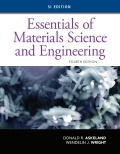
(a)
Interpretation:
Substitution of Mg2+ for yttrium ions in Y2O3 causes the point defect in Y2O3 structure. Changes required in structure to maintain charge balance are to be explained.
Concept Introduction:
Point defect can be defined as the missing of an atom from its crystal lattice or presence at irregular place in its crystal lattice. Point defects can be of many types such as self-interstitial atoms, interstitial impurity atoms, vacancies, and substitution atoms.
(b)
Interpretation:
Substitution of Fe3+ for magnesium ions in MgO causes the point defect in MgO structure. Changes required in structure to maintain charge balance is to be explained.
Concept Introduction:
Point defect can be defined as the missing of an atom from its crystal lattice or presence at irregular place in its crystal lattice. Point defects can be of many types such as self-interstitial atoms, interstitial impurity atoms, vacancies, and substitution atoms.
(c)
Interpretation:
Substitution of Li1+ for magnesium ions in MgO causes the point defect in MgO structure. Changes required in structure to maintain charge balance is to be explained.
Concept Introduction:
Point defect can be defined as the missing of an atom from its crystal lattice or presence at irregular place in its crystal lattice. Point defects can be of many types such as self-interstitial atoms, interstitial impurity atoms, vacancies, and substitution atoms.
(d)
Interpretation:
Substitution of Fe2+ for sodium ions in NaCl causes the point defect in NaCl structure. Changes required in structure to maintain charge balance is to be explained.
Concept Introduction:
Point defect can be defined as the missing of an atom from its crystal lattice or presence at irregular place in its crystal lattice. Point defects can be of many types such as self-interstitial atoms, interstitial impurity atoms, vacancies, and substitution atoms.
Want to see the full answer?
Check out a sample textbook solution
Chapter 4 Solutions
Essentials of Materials Science and Engineering, SI Edition
 MATLAB: An Introduction with ApplicationsEngineeringISBN:9781119256830Author:Amos GilatPublisher:John Wiley & Sons Inc
MATLAB: An Introduction with ApplicationsEngineeringISBN:9781119256830Author:Amos GilatPublisher:John Wiley & Sons Inc Essentials Of Materials Science And EngineeringEngineeringISBN:9781337385497Author:WRIGHT, Wendelin J.Publisher:Cengage,
Essentials Of Materials Science And EngineeringEngineeringISBN:9781337385497Author:WRIGHT, Wendelin J.Publisher:Cengage, Industrial Motor ControlEngineeringISBN:9781133691808Author:Stephen HermanPublisher:Cengage Learning
Industrial Motor ControlEngineeringISBN:9781133691808Author:Stephen HermanPublisher:Cengage Learning Basics Of Engineering EconomyEngineeringISBN:9780073376356Author:Leland Blank, Anthony TarquinPublisher:MCGRAW-HILL HIGHER EDUCATION
Basics Of Engineering EconomyEngineeringISBN:9780073376356Author:Leland Blank, Anthony TarquinPublisher:MCGRAW-HILL HIGHER EDUCATION Structural Steel Design (6th Edition)EngineeringISBN:9780134589657Author:Jack C. McCormac, Stephen F. CsernakPublisher:PEARSON
Structural Steel Design (6th Edition)EngineeringISBN:9780134589657Author:Jack C. McCormac, Stephen F. CsernakPublisher:PEARSON Fundamentals of Materials Science and Engineering...EngineeringISBN:9781119175483Author:William D. Callister Jr., David G. RethwischPublisher:WILEY
Fundamentals of Materials Science and Engineering...EngineeringISBN:9781119175483Author:William D. Callister Jr., David G. RethwischPublisher:WILEY





